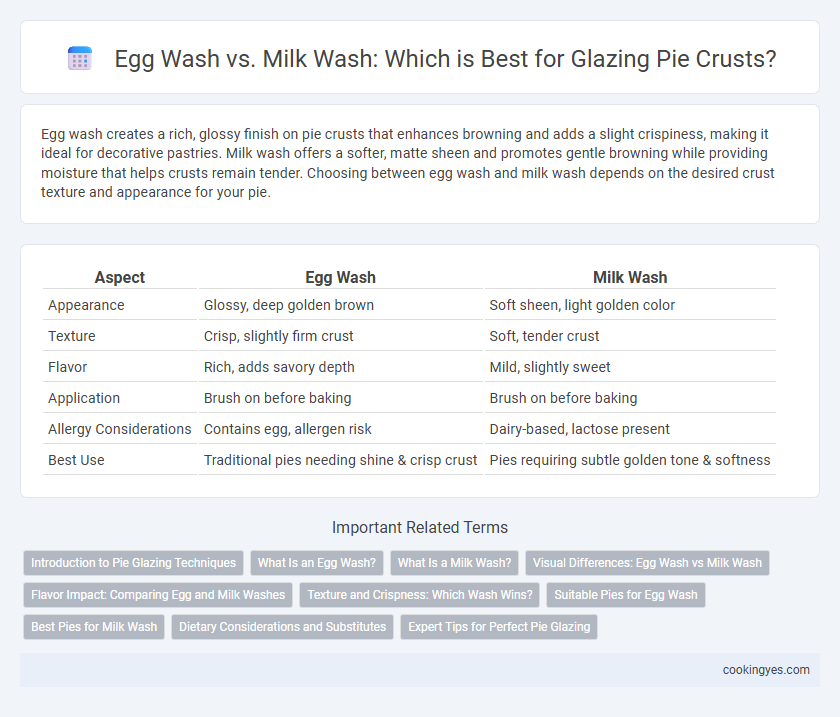Egg wash creates a rich, glossy finish on pie crusts that enhances browning and adds a slight crispiness, making it ideal for decorative pastries. Milk wash offers a softer, matte sheen and promotes gentle browning while providing moisture that helps crusts remain tender. Choosing between egg wash and milk wash depends on the desired crust texture and appearance for your pie.
Table of Comparison
| Aspect | Egg Wash | Milk Wash |
|---|---|---|
| Appearance | Glossy, deep golden brown | Soft sheen, light golden color |
| Texture | Crisp, slightly firm crust | Soft, tender crust |
| Flavor | Rich, adds savory depth | Mild, slightly sweet |
| Application | Brush on before baking | Brush on before baking |
| Allergy Considerations | Contains egg, allergen risk | Dairy-based, lactose present |
| Best Use | Traditional pies needing shine & crisp crust | Pies requiring subtle golden tone & softness |
Introduction to Pie Glazing Techniques
Egg wash creates a glossy, golden-brown crust on pies by enhancing caramelization during baking, while milk wash provides a softer, matte finish with subtle browning. Both glazing techniques improve crust texture and appearance, but egg wash is favored for its rich color and shine. Choosing between egg and milk wash depends on desired visual effect and crust crispness in pie preparation.
What Is an Egg Wash?
An egg wash is a mixture typically made from beaten eggs and a small amount of water or milk, applied to pie crusts before baking to achieve a glossy, golden-brown finish. This glaze enhances the pie's appearance and helps toppings like sugar or seeds adhere better. Egg wash is preferred over milk wash for its superior shine and richer color development in baked pies.
What Is a Milk Wash?
A milk wash is a simple mixture of milk applied to pie crusts before baking to create a soft, lightly browned finish. It enhances the crust's appearance by promoting gentle browning and a slightly glossy texture without the shine that an egg wash provides. This glazing technique is favored for its subtle color development and tender crust surface on fruit and cream pies.
Visual Differences: Egg Wash vs Milk Wash
Egg wash creates a shiny, golden-brown finish on pie crusts due to its protein and fat content, enhancing the crust's crispiness and color depth. Milk wash results in a softer, matte appearance with a light browning effect, producing a tender crust texture without the glossy sheen. Choosing between egg wash and milk wash dramatically impacts the pie's visual appeal, with egg wash offering a more vibrant, polished look compared to the subtle, rustic finish of milk wash.
Flavor Impact: Comparing Egg and Milk Washes
Egg wash imparts a rich, glossy finish to pies, enhancing both flavor and appearance with a slightly savory undertone from the protein content. Milk wash delivers a lighter, subtler browning effect, contributing a mild sweetness without overpowering the pie's natural flavors. Choosing between egg and milk wash depends on whether a more pronounced savory glaze or a gentle, sweetened crust is desired for the pie.
Texture and Crispness: Which Wash Wins?
Egg wash creates a glossy, golden-brown crust with a crisp texture due to its protein content that coagulates and firms up during baking. Milk wash yields a softer, matte finish with a slight sheen and less crispness, as the lactose caramelizes gently without forming a hard crust. For a pie crust that's both visually appealing and satisfyingly crunchy, egg wash typically offers the superior texture and crispness.
Suitable Pies for Egg Wash
Egg wash creates a shiny, golden-brown crust ideal for savory pies like chicken pot pie, meat pies, and quiches, enhancing their rich, hearty fillings. It is also suitable for sweet pies with sturdy crusts such as apple, cherry, or pecan, providing a crisp finish that contrasts well with juicy interiors. The protein and fat in egg wash promote a deeper color and slight gloss, making it perfect for pies requiring a polished, appetizing appearance.
Best Pies for Milk Wash
Milk wash creates a softer, matte finish ideal for fruit pies like apple, cherry, and peach, enhancing their natural sweetness without overpowering the filling. It helps achieve a tender crust that browns gently and evenly, preserving the pie's delicate flavors. This wash is perfect for pies with intricate lattice tops or crumb toppings where a subtle glaze is preferred over a glossy shine.
Dietary Considerations and Substitutes
Egg wash, made from beaten eggs or egg yolks, provides a glossy, golden finish but may pose allergy concerns and is not suitable for vegans. Milk wash offers a milder sheen with a softer crust, serving as a dairy option but requires alternatives like plant-based milks for lactose intolerance or vegan diets. Common substitutes include aquafaba or oil-based washes, which accommodate diverse dietary needs while maintaining appealing pie glaze results.
Expert Tips for Perfect Pie Glazing
Egg wash creates a glossy, golden-brown finish with a slightly crisp texture, making it ideal for decorative pie crusts and intricate designs. Milk wash offers a softer, matte sheen and helps achieve a tender crust while enhancing browning without overpowering crust flavor. Experts recommend using egg wash for visually striking pies and milk wash for delicate pastries to balance appearance and texture.
Egg wash vs Milk wash for pie glazing Infographic

 cookingyes.com
cookingyes.com